Bekhterev's disease
Back pain is one of the most common complaints with which patients turn to a neurologist. As often happens, they are given one of the most "popular" diagnoses - osteochondrosis of the spine. In fact, this term can hide a rather dangerous disease that makes a person disabled - Bechterew's disease.
This disease has been known to mankind since ancient times. The first description of patients with Bechterew's disease occurs in 1559 in the writings of Realdo Colombo. A more detailed picture of an unusual disease was revealed 100 years later, in 1693, by Bernard Connor. And at the end of the 19th century, several researchers from different countries published the results of their research on ankylosing spondylitis:
- 1892 - Russian neurologist and psychiatrist V.M. Bekhterev;
- 1897 - German doctor A. Strümpel;
- 1898 - Frenchwoman and physician P. Marie.
Their research made up the knowledge base of physicians about the disease, which eventually became known as Bechterew-Strumpel-Marie disease. In Russian-language literature, it was reduced to Bekhterev's disease.
3 Symptoms of the development of ankylosing spondylitis
4 Classification and stages of development of Bechterew's disease
Disease Definition
Ankylosing spondylitis (AS) is an inflammation of the intervertebral joints followed by ankylosis. Ankylosis - immobility of the joint, which arose due to the fusion of its individual parts. Spondyloarthritis indicates where and why this immobility arose: inflammation of the spine.
As a result of the pathological process, the spinal column is in a hard case, which significantly limits movement in it. The range of motion in the joints gradually decreases, the spine becomes immobile, gradually turns into a "bamboo stick" - the head, body and hips are connected into a single whole, and the rest of the body and joints remain mobile, as before.
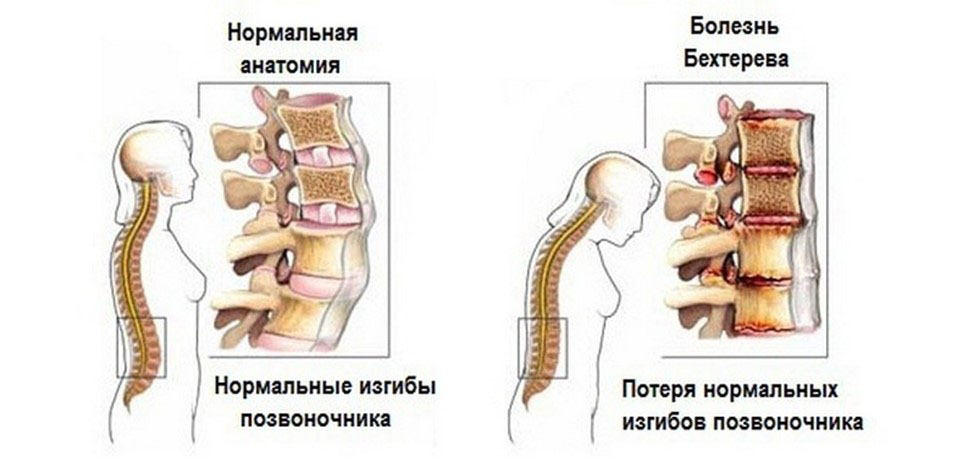
Cause of the disease
The cause of Bechterew's disease has not yet been clarified. There are certain risk factors:
- Heredity (at least 20%).
- Transferred infectious disease of the intestine or genitourinary system.
- Increased activity of one of the types of bacteria Klebsiella (Klebsiella pneumoniae) and some strains of Yersinia (Yersinia enterocolitica)
- restless legs disease - occurs in patients with Bechterew's disease almost 3 times more often than in healthy people;
- birth weight less than 3 kg;
- hospitalization with infectious diseases at the age of 5 to 12 years.
Doctors have long known about the histocompatibility gene HLA-B27, the presence of which increases the risk of developing the disease by 80 times. In 2011 studies, several genes were identified that are involved in the development of ankylosing spondylitis by interacting with HLA-B27. For example, some variants of the ERAP1 gene increase a person's susceptibility to disease, while others, on the contrary, protect against it.
In this process, the aggression of the immune system against the musculoskeletal system (inadequate immune response) occurs. Immunity mistakenly and aggressively perceives some tissues of the body as foreign, therefore ankylosing spondylitis belongs to the section of autoimmune diseases.
Symptoms of the development of ankylosing spondylitis
Ankylosing spondylitis usually begins to develop at the age of 20-30 years, men get sick 5 times more often than women. The disease creeps up imperceptibly, but there are several signs-harbingers, the appearance of which should alert a person. If one or more symptoms appear, a consultation with a rheumatologist is necessary. Some patients experienced constant weakness, drowsiness, irritability, mild flying pains in the joints and muscles for several months or even years before the onset of the disease. During this period, the symptoms are mild and patients, as a rule, do not go to the doctor.
In about 80% of cases, ankylosing spondylitis begins with inflammation and back pain, in 20% - with peripheral arthritis.
A characteristic early symptom of Bechterew's disease is pain and a feeling of stiffness in the lumbar spine, with the gradual involvement of its neighboring departments.
Distinctive moment: the pain becomes stronger closer to the morning and mostly at rest, after a long rest. Decreases after hot showers and exercise.
Among the symptoms, pain in the heel bones is also distinguished.
Often, the development of pain in the heel in men under the age of 30 is the first sign of the disease. If there is inflammation of the calcaneal tendon and this was not preceded by an injury, then the chance that it could be AS reaches 90% (Fig. 1).
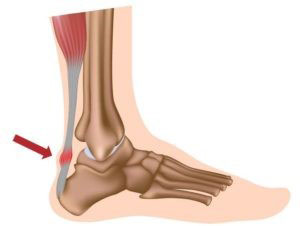
Fig.1 Inflammation of the Achilles tendon
Pain is well relieved by taking non-steroidal anti-inflammatory drugs (NSAIDs), but returns again after the cessation of their action.
Over time, the spine begins to lose its mobility and the patient cannot lean forward. A person gradually loses the lumbar curve - lordosis, this part of the spine becomes flat. Its ossification develops from the bottom up, mobility restrictions in the neck develop at a rather late stage. In the worst case, the disease quickly reaches the neck. If the cervical spine is already affected, the patient acquires a characteristic "bulging hunchback" - doctors call it the "beggar's posture".
Stiffness in the thoracic spine. When the vertebrae of the thoracic region are involved in the process, the ability to breathe worsens, which is why chronic lung diseases develop. When coughing, active breathing or sneezing, the pain becomes stronger (if the costovertebral joints are involved).
The spine is the center of our body, so its disease is reflected in other joints. The shoulders, hips, lower jaw, sternum, joints of the limbs may begin to hurt. In Bechterew's disease, unlike arthritis, the joints are not destroyed, but the mobility in them decreases every year.
Every third patient with ankylosing spondylitis develops eye lesions - uveitis (inflammation of the choroid of the eye) and iridocyclitis (inflammation of the iris and ciliary body) are detected.
In second place in terms of prevalence is damage to the work of the heart, which is manifested by arrhythmias, disorders of the heart valves, inflammation of the aortic wall, etc.
Fibrosis of lung tissues often develops, kidneys and the nervous system are damaged.

Classification and stages of development of Bechterew's disease
Clinical variants (forms) of Bechterew's disease:
- Central form - only the spine is involved.
- Kyphotic - changes in the cervical and thoracic zones of the spine lead to the fact that the body leans forward more and more, a "beggar" pose is formed.
- Rigid - smoothing all the curves of the spine, the back becomes flat, the head leans back slightly, a "proud" pose appears.
- Rizomelic form - involvement of the spine and root joints (shoulder and hip).
- Peripheral form - involvement of the spine and peripheral joints (knee, ankle, etc.).
- The Scandinavian form involves the small joints of the hands and spine.
- The visceral form is one of the forms listed above and involves the visceral organs (heart, aorta, kidneys).
Diagnostic features
Diagnostic signs of ankylosing spondylitis on the recommendation of the Institute of Rheumatology of the Russian Academy of Medical Sciences, 1997.
- Lower back pain that does not go away with rest, improves with movement, and lasts more than three months.
- Limitation of mobility in the lumbar spine - with forward-backward and right-left tilts.
- Restriction of respiratory excursion of the chest (the difference between the circumference of the chest at full inhalation and maximum exhalation) relative to normal values in accordance with age and gender.
- Bilateral sacroiliitis (inflammation of the sacroiliac joint) stage II-IV.
The diagnosis is considered reliable if the patient has the fourth sign in combination with any other of the first three.
Late diagnosis of ankylosing spondylitis is explained by the general symptoms of rheumatological diseases.
Mandatory is X-ray examination, magnetic resonance imaging. The main criterion is changes in the sacroiliac region.
Genetic diagnostics for the presence of the HLAB27 antigen is mandatory.
The diagnosis of AS is made on the basis of a comprehensive examination, including examination of the patient, analysis of complaints, clinical, laboratory and instrumental diagnostics, X-ray examination data and MRI.
Complications of ankylosing spondylitis
The most common:
- amyloidosis of the kidneys, which further leads to the development of renal failure;
- inflammation of the lungs due to decreased mobility of the chest;
- inflammation of the iris of the eye, leading to loss of vision;
- vascular damage, which increases the risk of heart attack and stroke;
- osteoporosis
- compression of the bundle of nerve roots of the lower parts of the spinal cord "cauda equina syndrome", which leads to incontinence of urine and feces, paralysis of the legs;
- smoothing the curves of the spine ("proud" pose);
- immobility.
To prevent the occurrence of serious and dangerous complications of Bechterew's disease, it is necessary to detect, diagnose and treat the disease in a timely manner as soon as possible.
Treatment
Therapy for this pathology is long-term and should be comprehensive. The goal of treatment is to stop or slow the progression of the disease. It is necessary to observe continuity at all stages of treatment: hospital (department of traumatology, rheumatology) - polyclinic - sanatorium. Glucocorticoids and non-steroidal anti-inflammatory drugs, therapeutic blockades are prescribed. For severe treatment, immunosuppressants are prescribed.
The most important part of therapy is rehabilitation. Exercise therapy is the basis of therapy, it is she who will not allow the state of health to deteriorate.
Individual exercises in therapeutic gymnastics are compiled, which must be performed daily. It is recommended to sleep on a hard bed without a pillow and regularly engage in sports that strengthen the back muscles (swimming, skiing). To maintain the mobility of the chest, it is necessary to perform breathing exercises, be sure to practice diaphragmatic breathing.
Physiotherapy treatment
In addition to medications and gymnastics, physiotherapy is added, which should be carried out taking into account the stage of the disease, its form and the degree of activity of the pathological process.
With a high activity of ankylosing spondylitis, ultraviolet (UV) irradiation of the spine is indicated, which stimulates the function of the adrenal cortex, the reticuloendothelial system, enhances phagocytosis, and accelerates immunological reactions. The result is an analgesic, anti-inflammatory and hyposensitizing effect.
With a pronounced pain syndrome, electrophoresis with novocaine has a good effect.
In the presence of active inflammation of the peripheral joints, UHF therapy on the affected joints is recommended.
In Bechterew's disease in the stage of medium or low activity, as well as in the inactive phase of the disease, physiotherapy methods are used much more widely.
In these stages, inductothermia, microwave and decimeter therapy, ultrasound, ultraphonophoresis with hydrocortisone are shown.
With an average degree of activity, a good effect is obtained by mud therapy in combination with the use of anti-inflammatory drugs, microwave, ultrasound therapy, acupuncture, Lyapko application therapy, massage, visceral massage of the abdomen according to Ogulov A.T. (massage of internal organs through the anterior abdominal wall), lymphatic masses abdomen according to Shishova O.I., etc.

Application therapy Lyapko
Lyapko's applicators in various modifications (plates, rollers, applique belts, applique tapes) are an original, powerful device with many health-improving therapeutic possibilities.
Their action is based on the principles of traditional Chinese medicine - superficial multi-needle acupuncture, as well as on the general physiological mechanisms of life.
Mechanisms of action of the applicator
The high healing effect of Lyapko applicators is due to a combination of intense reactions:
- reflex-mechanical;
- galvano-electric;
- immunological.
Application therapy has a pronounced analgesic and antispasmodic effect. Improves blood circulation, lymph flow, microcirculation, reduces tissue swelling. It activates tissue mechanisms of immune defense, increases the level of its own opiate peptides and anti-stress hormones in the blood, reduces the sensitivity of pain receptors, has a positive psycho-emotional effect and, as a result, stimulates the general adaptive mechanisms of a person. In contact with the skin, the applicator needles stimulate the release of a person’s internal medicines, including his “inner doctor” in his work.
Applicators are widely used in medical institutions, in health centers and sanatoriums, they are compatible with all types of medical and physiotherapy treatment.
Ease of use, safety, high efficiency with minimal effort allow us to recommend applicators for self-use at home.
It is important to note that the local (local) improvement of blood circulation during application therapy occurs without additional stress on the heart, since the work of the peripheral circulation increases and the heart rests at this time. This is very important for all categories of patients, and especially for those with coronary heart disease, 1-2 degree circulatory failure, and the elderly.
The therapeutic effect of applicators is enhanced if they are applied to the skin, previously moistened with water, hypertonic solution or gauze with a decoction of medicinal herbs, water-based drugs. After removing the applicator, all the pores of the skin in the place of its application are opened and the application of therapeutic oils, ointments and compresses is most effective.

How to work with the applicator, application zones
In 90% of cases, it is necessary to act on the pain zone, and to increase efficiency on additional and auxiliary zones.
It is always necessary to include the main zone (the region of the spine) in the general recipe.
The main zones are located on the back surface of the trunk, head, neck.
The main ones are named due to the fact that the skin areas on both sides of the spine and directly above the spine are closest to the exits of the roots of the cranial and spinal nerves and other structures.
Auxiliary zones - the front surface of the trunk, head and neck.
Due to the fact that the internal organs and glands of internal secretion are located directly under the anterior abdominal wall, under the chest, in the neck, face, exposure to them or to individual skin areas (metamers) in these areas with the help of different metal needle applicators contributes to the regulation, normalization, restoration, improvement and activation of the activity of these organs. The result is achieved faster when using auxiliary zones simultaneously with the main and additional zones.
Additional zones: zones of the skin of the lower and upper extremities, which are secondary (peripheral) in relation to the (central) structures of the spinal cord and brain.
Important. Since a common cause of all autoimmune diseases are infectious diseases of the intestines or the genitourinary system, it is imperative to restore the movement of lymph and blood in the abdomen.
Lyapko's application therapy is indicated to improve the functioning of the abdominal organs, intestines, where the largest amount of lymphoid tissue is located, which is responsible for the functioning of the immune system.
To do this, it is recommended to use flat applicators on the lower thoracic and lumbosacral spine, additionally on the auxiliary zone - the anterior abdominal wall (simultaneously or alternately), you can also wrap these zones with the "Health Magic Tape" for 20-30 minutes or roll these areas with application rollers for 10-15 minutes.
Lyapko application therapy is used both as an independent procedure and as a preparation for relaxing the muscles of the anterior abdominal wall for visceral massage of the abdomen.
These procedures improve the functioning of internal organs, relieve congestion, inflammation in them, restore the functioning of the lymphatic system, and increase immunity.
It is recommended to use large-sized flat applicators on the back area: Applicator "Large mat" , "Massage needle large mat" , "Chance 6.2x4" , "Folk" .
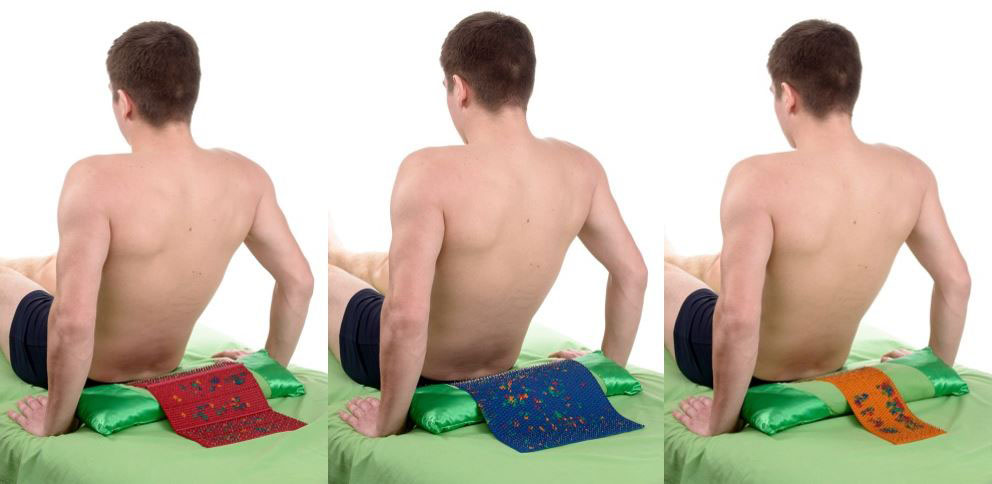
"Chamomile M" , "Quadro" . The larger the impact area, the better the effect.

It is also possible to use smaller flat applicators: “Needle massage pillow”, “Insoles plus” , “Chance” , “Sputnik plus”which are placed on the area of pain. In addition to the back area, to enhance the effect, it is recommended to use applicators on auxiliary zones on the front surface of the body, in the area of pain projection. For example: pain in the lumbosacral spine - place the applicator on the lower abdomen. In addition, the use of applicators on the area of the kidneys, adrenal glands (under the control of blood pressure - do not use at elevated pressure), on the abdomen improves the functioning of the immune system. The exposure time is 20–30 minutes, the course of treatment is 10–14 days, which can be repeated after a break in 1–2 weeks. Such procedures can be applied in courses for a long time.
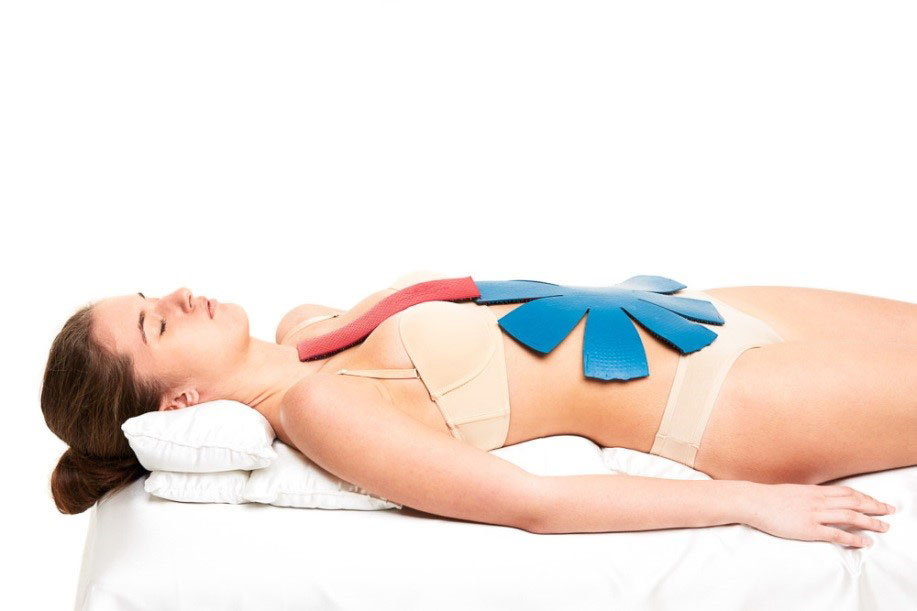
To complete the session, it is better to act on the feet using the Insole Plus applicator, which can also be applied to all parts of the body.

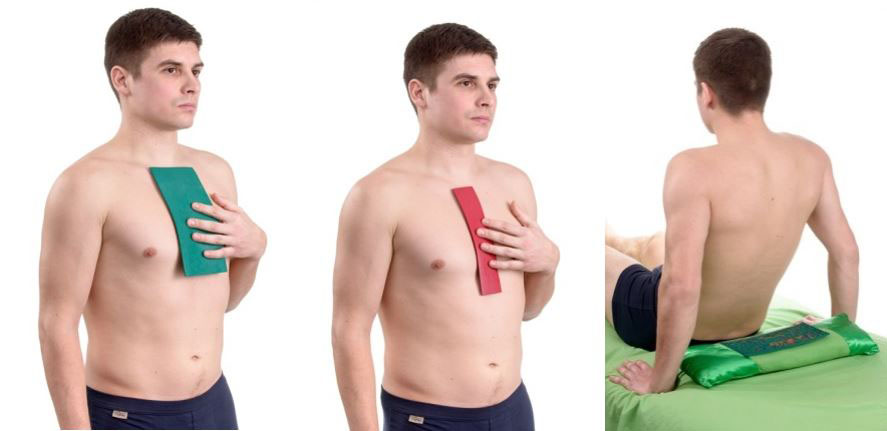
In addition to flat applicators, it is possible to roll in the area of the back, the front surface of the torso, arms, legs with the “Large Roller M” or “Universal Roller M” until a uniformly pink color of the skin appears. They can also be used to warm up the body before a massage.
First, roll with a roller along the spine, along the intercostal spaces on one side, until a uniformly pink color appears. Then, in the same way, we roll the second side. The exposure time is 3–7–10 minutes, depending on the individual skin reaction.
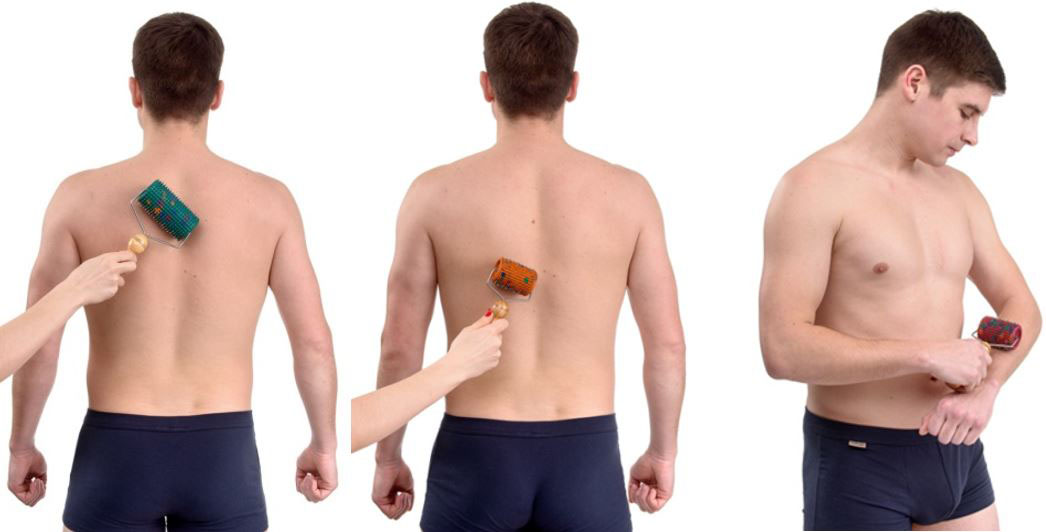
Belt "Baby" , Belt "Universal M" is fixed across and along the spine to the pain zone or is used in the prone position, like a regular applicator.
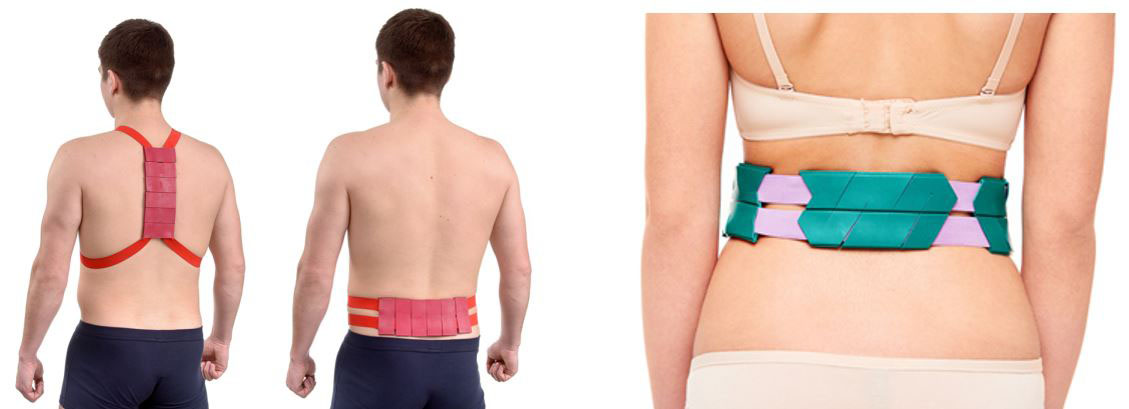
You can also wrap the pain area with Magic Tape "Health" .
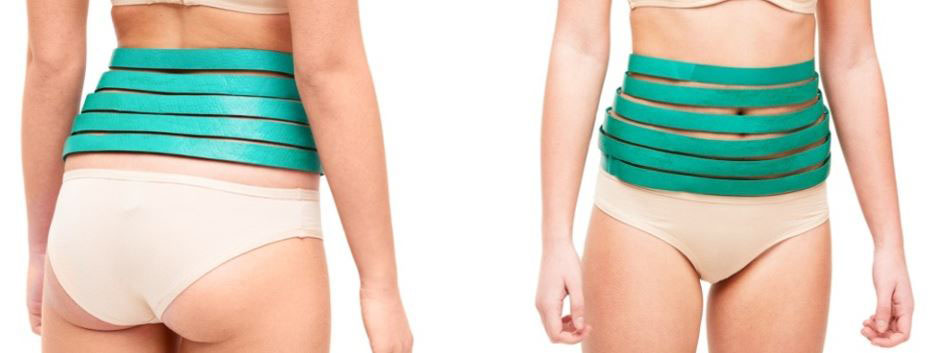
Kraplinka applicator can be fixed on the pain area. Given the small area of impact, long-term wearing - 1 - 3 hours.
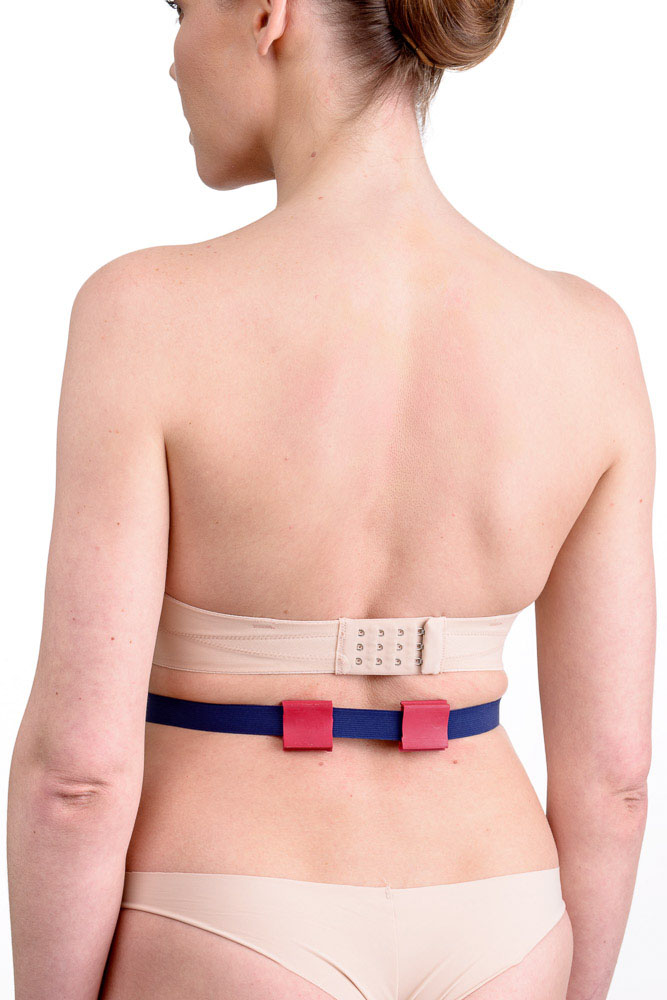
You can use both a manual back massage and massage using the Pharaoh massager , which can be worked through a thin cloth or over a body lubricated with oil, cream. The duration of the massage and its intensity determines the desired effect. Long, up to 15 min. and more, massage contributes to the complete relaxation of muscles, creates a sedative (calming) effect.
After the massage, we recommend laying on a flat applicator for rest and relaxation.
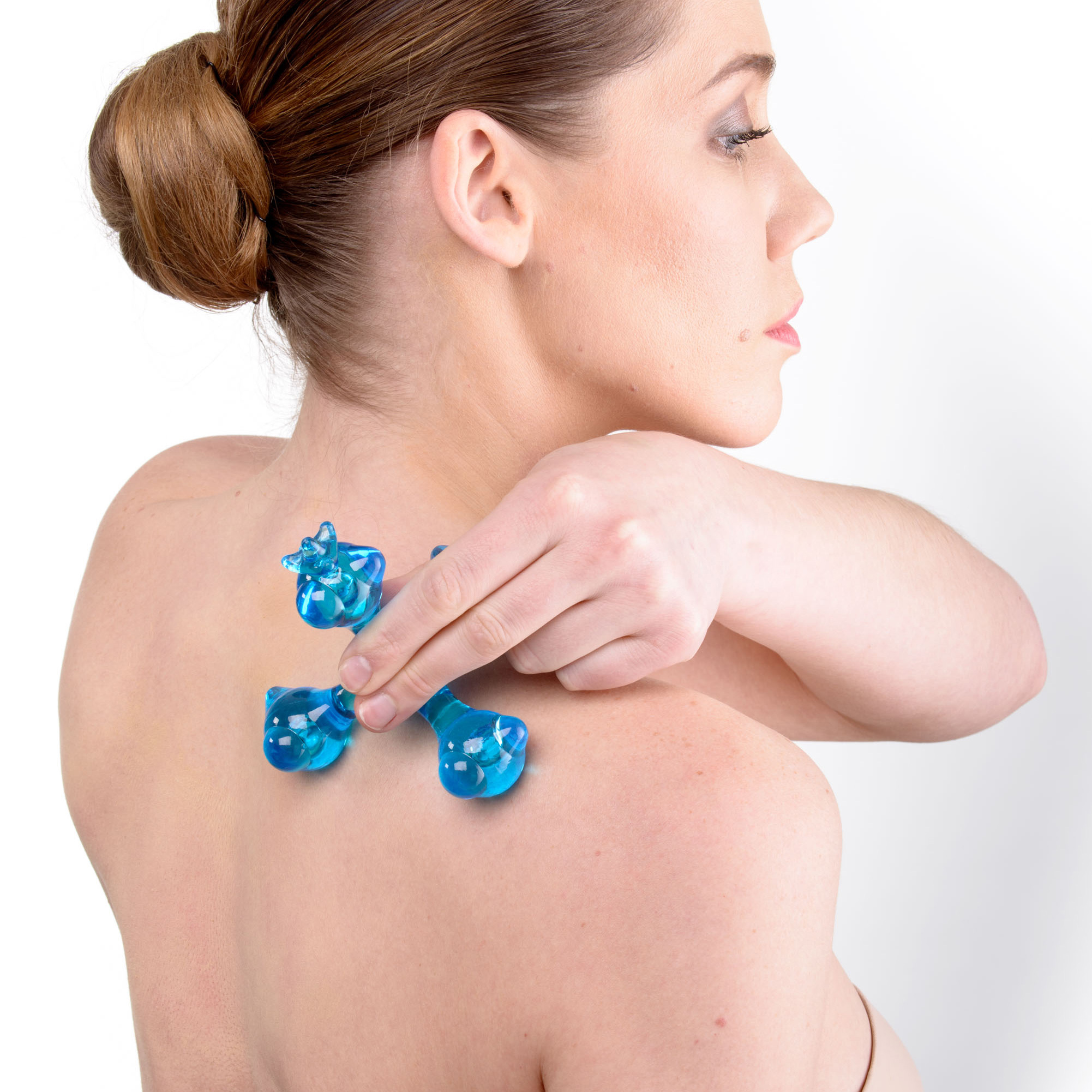
For joint pain
In case of damage to the joints of the upper extremities, it is necessary to act with applicators on the cervical-collar spine, from where the innervation to the upper extremities comes, then on the joint area.
In case of damage to the joints of the lower extremities - apply applicators to the lumbosacral spine, from where the innervation to the lower extremities comes, then to the joint area.
You can act simultaneously or sequentially.
The applicator "Chamomile M" is especially convenient to use , which, thanks to its flexible "petals", acquires the relief of any part of the body. They can have an impact on any part of the spine, hip and knee joints (fixed with an elastic bandage); apply to calves, feet.
The exposure time with flat applicators is 20-30 minutes.

You can also use static-dynamic applicators: "Magic tape "Health" , belt "Universal M" , belt "Baby" . Uniform pressure on the surface of the body and ease of fixation allows you to move freely, do the usual thing and at the same time be treated.
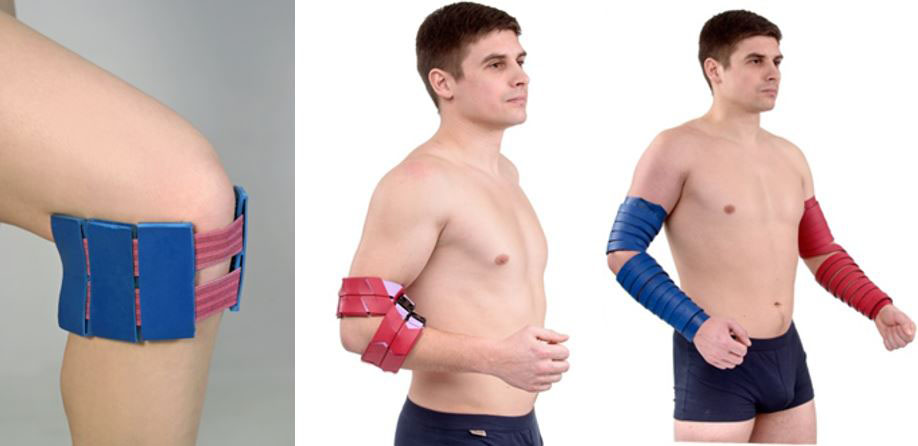
It is recommended to fix the applicator for 20-30 minutes to the areas of damaged joints; in addition, you can use the zones of the opposite healthy side for 10-15 minutes. The procedure takes 20-40 minutes, the course of treatment is 1-2 weeks, the treatment can be repeated after 2-4 weeks.
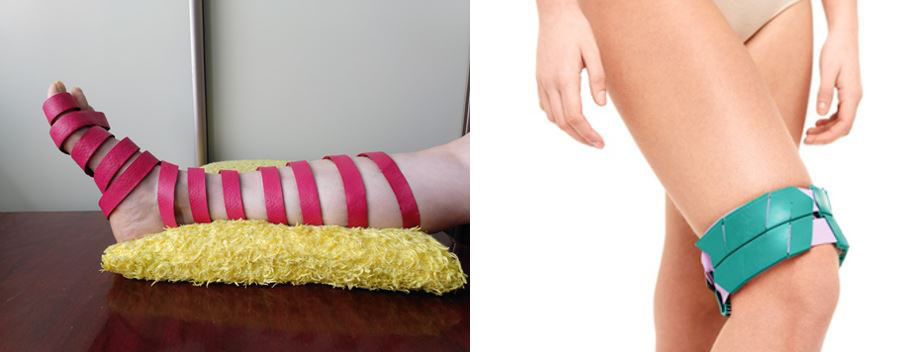
It is also necessary to massage the upper and lower extremities, the corresponding zones of the spine, the joint, for example, using the Pharaoh massager, but at the same time, direct exposure to the diseased joint should be avoided, as this can increase the inflammatory reaction in it, work above and below the joint .
conclusions
There is no cure for ankylosing spondylitis. A person with such a diagnosis will have to be constantly monitored by a specialist, and during periods of exacerbation, one should be in a hospital in a trauma or rheumatology department.
Rehabilitation is the most important part of therapy. It is necessary to regularly perform special exercises selected by qualified specialists in the field of rehabilitation, as well as use at home such available physiotherapy tools as the Lyapko applicator.
Ankylosing spondylitis, when properly treated, usually has a good prognosis with milder symptoms and significantly slows progression.
The use of Lyapko application devices is an excellent prophylactic and a guarantee of your health, vitality and good mood!
